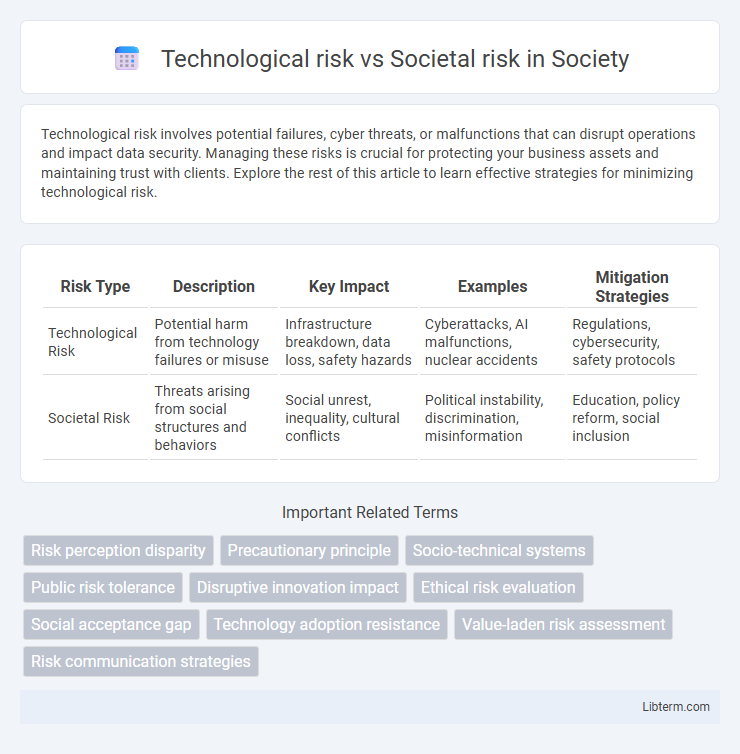Technological risk involves potential failures, cyber threats, or malfunctions that can disrupt operations and impact data security. Managing these risks is crucial for protecting your business assets and maintaining trust with clients. Explore the rest of this article to learn effective strategies for minimizing technological risk.
Table of Comparison
| Risk Type | Description | Key Impact | Examples | Mitigation Strategies |
|---|---|---|---|---|
| Technological Risk | Potential harm from technology failures or misuse | Infrastructure breakdown, data loss, safety hazards | Cyberattacks, AI malfunctions, nuclear accidents | Regulations, cybersecurity, safety protocols |
| Societal Risk | Threats arising from social structures and behaviors | Social unrest, inequality, cultural conflicts | Political instability, discrimination, misinformation | Education, policy reform, social inclusion |
Introduction to Technological and Societal Risks
Technological risks involve potential hazards arising from the development, deployment, or failure of technology systems, including cybersecurity breaches, automation errors, and infrastructure breakdowns. Societal risks encompass broader threats to communities and social structures, such as social inequality, cultural disruption, and public health crises triggered by technological advancements. Understanding the distinction between technological and societal risks is crucial for effective risk management and policy-making in technology-driven environments.
Defining Technological Risk
Technological risk refers to the potential for harm or loss resulting from the development, deployment, and use of technologies, encompassing failures, malfunctions, or unintended consequences. It includes risks such as data breaches, cyberattacks, system failures, and the ethical implications of emerging technologies like artificial intelligence and biotechnology. Understanding technological risk involves evaluating vulnerabilities in hardware, software, infrastructure, and human factors to mitigate adverse impacts on individuals and society.
Understanding Societal Risk
Understanding societal risk involves analyzing the potential impact of technological advancements on communities, including disruptions to social structures, economic inequalities, and cultural dynamics. Unlike technological risk, which focuses on system failures or technical malfunctions, societal risk evaluates broader consequences such as public health, environmental changes, and social cohesion. Effective risk management requires integrating interdisciplinary perspectives to anticipate and mitigate the complex interactions between technology and society.
Key Differences Between Technological and Societal Risks
Technological risks primarily stem from failures or malfunctions in engineered systems, such as software bugs, hardware breakdowns, or cyber-attacks, whereas societal risks arise from large-scale social, economic, or political disruptions like social unrest or economic collapse. Technological risks are often quantifiable through probability assessments and engineering metrics, whereas societal risks involve complex human behaviors and cultural dynamics, making them less predictable and harder to model. The mitigation of technological risks typically involves technical solutions and regulatory standards, while societal risk management requires policy interventions, social reforms, and stakeholder collaboration.
Common Examples of Technological Risks
Common examples of technological risks include cyberattacks, data breaches, and system failures that disrupt critical infrastructure like power grids and communication networks. Industrial accidents such as chemical spills, nuclear meltdowns, and automation errors also pose significant threats to public safety and environmental health. These technological risks often result from software vulnerabilities, hardware malfunctions, or inadequate security measures, highlighting the need for robust risk management strategies in engineering and technology sectors.
Major Instances of Societal Risks
Major instances of societal risks include pandemics, economic inequality, social unrest, and climate change-driven disasters, all of which pose widespread threats to public health, stability, and resources. Unlike technological risks that often stem from system failures or cyber threats, societal risks arise from complex social dynamics and human behaviors impacting large populations. Addressing societal risks requires comprehensive policy frameworks, interdisciplinary research, and community engagement to enhance resilience and mitigate potential crises.
Intersections and Overlaps: When Tech Risk Becomes Societal Risk
Technological risk often transforms into societal risk when innovations disrupt social structures, such as the widespread impact of AI on employment and privacy. Cybersecurity breaches exemplify this intersection, where technical vulnerabilities lead to large-scale social consequences like identity theft and misinformation. The convergence requires comprehensive risk management strategies that address both technological flaws and their broader societal ramifications.
Assessing and Measuring Both Risks
Assessing technological risk involves quantifying the probability and impact of system failures, cyberattacks, or technological malfunctions using metrics such as failure rates, vulnerability indexes, and incident frequency. Societal risk assessment examines the potential harm to communities, including social disruption, public health consequences, and economic impact, often measured through social vulnerability indices, population exposure levels, and risk perception surveys. Both require integrating quantitative data with qualitative insights to develop comprehensive models that guide risk management and policy decisions.
Strategies for Mitigating Technological and Societal Risks
Mitigating technological risks involves implementing robust cybersecurity measures, conducting rigorous testing and quality assurance, and establishing comprehensive regulatory frameworks to ensure product safety and reliability. Strategies for societal risk mitigation focus on enhancing public education, fostering community engagement, and developing policies that promote social equity and resilience. Integrating multidisciplinary approaches and continuous risk assessment supports adaptive management, minimizing adverse impacts on both technology and society.
Future Trends: Emerging Risks in Technology and Society
Emerging risks in future technology include AI autonomy, quantum computing vulnerabilities, and biotech ethics, posing significant societal challenges such as privacy erosion, inequality, and governance gaps. Increasing interconnectivity escalates the potential for cascading failures across critical infrastructure and social systems, emphasizing the need for robust risk assessment frameworks. Proactive collaboration between technologists, policymakers, and communities is essential to anticipate, mitigate, and adapt to these evolving technological and societal risks.
Technological risk Infographic

 libterm.com
libterm.com